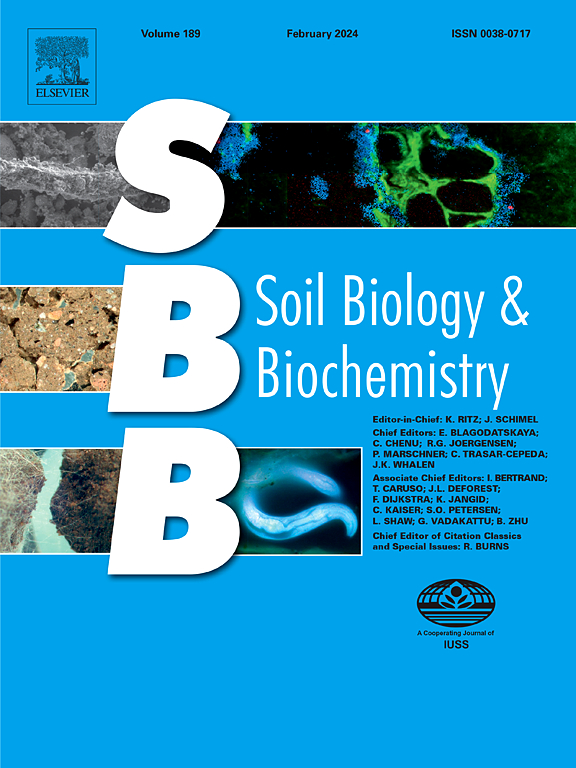Evaluating soil dissolved organic matter as a proxy for soil organic matter properties across diverse ecosystems
IF 9.8
1区 农林科学
Q1 SOIL SCIENCE
引用次数: 0
Abstract
Soil organic matter (SOM) includes the soil dissolved organic matter (SDOM), an active pool in carbon biogeochemistry that contributes to vital ecosystem services such as carbon sequestration. Although SDOM properties could be related to SOM bioavailability and persistence, it needs to be confirmed that SDOM properties are related to SOM dynamics in diverse ecosystems. We collected and analyzed 31 soil samples from three ecosystems (12 croplands, 8 grasslands, and 11 forests) in western China to assess the characteristics of SOM and SDOM using multiple methods, including optical, isotopic, biomarker, and wet chemical extraction methods. Three independent multifunctionality statistical methods were used to evaluate the measured SOM or SDOM properties, and to derive a quantitative metric of the SOM persistence, defined as the organic matter persistence index (PI). The influencial SOM and SDOM properties were further confirmed by feature selection algorithms. We evaluated the relationship between the PI derived from SOM (PISOM) and that of the SDOM (PISDOM). Generally, forest soil had the highest SOM persistence, followed by grasslands and then croplands. In forests and grasslands, PISDOM was highly positively related to PISOM, indicating that it is reasonable to evaluate SOM persistence using SDOM properties as proxies in those two ecosystems. In croplands, the SOM persistence was not strongly related to the SDOM properties. We conclude that SDOM properties can be assessed rapidly and conveniently as a surrogate for SOM bioavailability and persistence, the SDOM metrics should be used cautiously because the SDOM-SOM relationship is ecosystem-dependent. Overall, this work advances the application of multi-property statistical methods for better understanding of SOM properties.


评估土壤溶解有机质作为不同生态系统土壤有机质特性的代理
表征土壤有机质(SOM)对于理解其在生态系统服务(如碳固存)中的关键作用至关重要。土壤溶解有机质(SDOM)是土壤有机质中最活跃的成分,是土壤有机质生物地球化学的重要组成部分。因此,在未经事先验证的情况下,SDOM的特性经常被用作SOM的持久性和生物利用度的替代品。然而,SDOM属性在不同生态系统中如何很好地代表SOM属性经常被忽视。本文收集了中国西部3个生态系统(12个农田、8个草原和11个森林)的31个土壤样本,利用光学、同位素、生物标志物和湿化学提取等多种方法评估了土壤有机质和SDOM的特征。采用三种独立的多功能统计方法来评估多种散装SOM或SDOM的性能,并获得一个定量指标,定义为有机质持久性指数(PI),以评估SOM的持久性。评估了大体积SOM (PISOM)和SDOM (PISDOM)的PI之间的关系。我们观察到森林的总体模式显示出最高的SOM持久性,其次是草地,然后是农田。在森林和草地生态系统中,PISDOM与PISOM呈高度正相关,表明在这两个生态系统中,以SDOM属性作为代理评价SOM持久性是合理的。相比之下,我们建议在评估农田中SOM持久性时考虑大量SOM和SDOM特性。我们使用特征选择算法来确定bulk SOM和SDOM最有效的属性属性进行验证,这进一步支持了我们的结论。因此,本研究强调,在使用SDOM属性作为SOM属性的替代品时应谨慎,因为它们依赖于生态系统。重要的是,多属性统计方法提供了一种使用SDOM更好地理解SOM属性的方法,以便快速方便地进行评估。
本文章由计算机程序翻译,如有差异,请以英文原文为准。
求助全文
约1分钟内获得全文
求助全文
来源期刊

Soil Biology & Biochemistry
农林科学-土壤科学
CiteScore
16.90
自引率
9.30%
发文量
312
审稿时长
49 days
期刊介绍:
Soil Biology & Biochemistry publishes original research articles of international significance focusing on biological processes in soil and their applications to soil and environmental quality. Major topics include the ecology and biochemical processes of soil organisms, their effects on the environment, and interactions with plants. The journal also welcomes state-of-the-art reviews and discussions on contemporary research in soil biology and biochemistry.
 求助内容:
求助内容: 应助结果提醒方式:
应助结果提醒方式:


